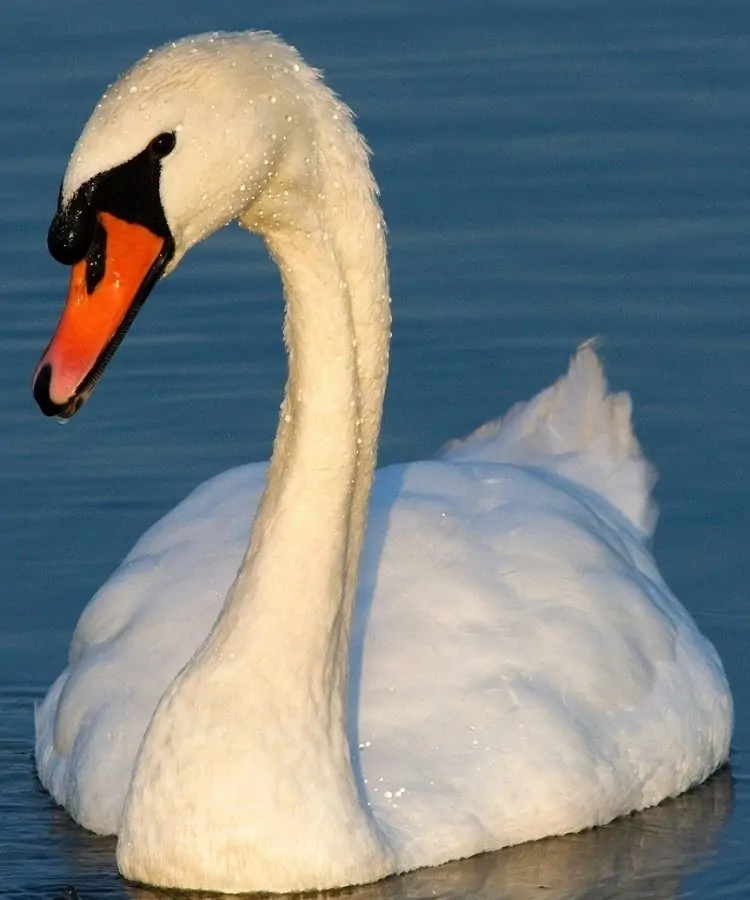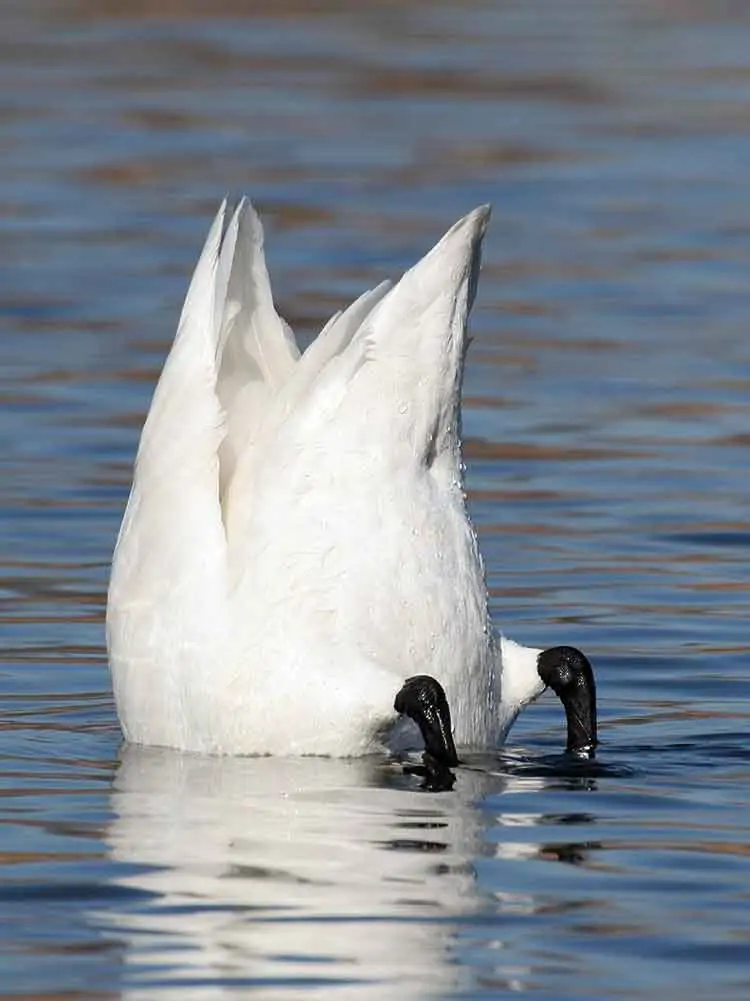The graceful swan is a symbol of beauty and peace. Swans are also very large birds that eat an enormous amount of food (approximately 1 kg). The question is: what do they eat? This blog post will answer that question, so you can feed your swan properly!
Swans are one of the largest waterfowl species of the Family Anatidae and subfamily Anserinae. Most swans are classified in the genus called Cygnus.
Swans are elegantly long-necked, big-footed, and heavy-bodied birds that glide royally when swimming. Swans fly with necks outstretched and with slow wingbeats. They migrate in V-formation or diagonal formation at great heights and move very fast on water or in the air.
Table of Contents
- 1 Swan Species
- 2 What’s the Food of Swans?
- 3 How Much Food Do Swans Need to Consume per Day?
- 4 How Do Swans Consume Food?
- 5 Required Water Conditions for Swans
- 6 [Video] The Bread Myth Busted
- 7 Frequently Asked Questions
- 7.1 What do swans eat primarily in their natural diet?
- 7.2 How much food do swans need to eat per day?
- 7.3 What is the ‘upending’ feeding technique swans use?
- 7.4 Do male and female swans eat different amounts and types of food?
- 7.5 Why do swans need to eat so frequently?
- 7.6 What vegetables can swans eat when on land?
- 7.7 Can swans drink saltwater, and what are their water requirements?
- 7.8 Why do swans prefer eating food on the water’s surface rather than diving?
- 7.9 What aquatic plants are most commonly found in a swan’s diet?
- 7.10 How does a swan’s diet change as they age?
Swan Species
There are many different species of swans in the world.
This is a list of all different types: American Black Swans, Mute Swans, Whistling Swans, and Whooper Swans, to name just a few! All these are elegant birds with long necks and prehistoric-looking wings that flap high up into the air as if to create more lift for their heavy bodies.
These six species belong to the Family Anatidae of Birds, which reside in the Genus Cygnus. Swans are also related to geese.
Six Major Swan Types
- The Whooper Swan
- The Mute Swan
- The Tundra Swan
- The Trumpeter Swan
- The Black Swan
- The Black-Necked Swan

What’s the Food of Swans?
Many people learn about the swans’ cultural significance through their ugly stories or their use in various military emblems. Swans are also known for some of their more appealing habits.
For example, they will feed their entire life almost exclusively on water. They are aggressive and will thoroughly protect their territory. Swans are also known as fascinating creatures who will become life partners (although they will be separated from their partners).
Let’s talk about their food. What do swans eat? And from where do they get most of their nutrition?
Swans Diet
As mentioned above, swans usually feed on water. They are primarily vegetarians and will thus enjoy all kinds of aquatic plants, which include the following:
- Milfoil
- Wild rice
- Waterweed
- Musk grass
- Creeping bent
- Plantago
- Coontail
- Canadian pondweed/Elodea
- Potamogeton
- Watercrow foot/Streamer weed
- Wild celery
- Hornwort
- Floating sweet grass
- Eel grass
- Sea arrow grass
- Marsh yellow-cress
- Foxtail stonewort
- Marsh foxtail
- Yellow cress
- Green algae
- Beaked tasselweed
- Sea plantain
- Saltmarsh grass
Except for these aquatic plants, they also eat small animals or fish in their vicinity. Well! We all want a change of taste, and the same goes for Swans.
Along with plants, they also eat the following animals:
Interestingly, female swans will generally ingest more significant quantities of pondweed and eat less waterweed, while it is vice versa in males. Similarly, Swan’s females also eat more amount of food as compared to males.
Swans are fascinating and majestic birds, so people see them as a positive aspect of their lives. Birds in private collections, urban areas, or sanctuaries are fed with those various food items they wouldn’t usually see in the wild.
Generally, people give bread and different type of grains to exotic or wild birds such as ducks, geese, and swans.
Usually, Swans eat their food underwater. While eating, they only raise their head above water when they seek any danger or disturbance in the surrounding.
They eat lettuce, potatoes, and other vegetables when they are on land. These food items usually enhance supplements to their routine aquatic diet.
How Much Food Do Swans Need to Consume per Day?
Generally, swans eat whenever they feel hungry.
On average, Swans’ average body weight is 21-27 pounds, and they have to eat a lot to maintain a massive body temperature of 106.2 degrees. Their feeding consumption is equal to 20-25% of their body weight per day (food worth about 4-7 pounds).
Swans are not those creatures that eat in too many large quantities, so they will graze for some time and return to their reliable food sources several times a day instead of using one large meal. Also, they do not have large stomachs and often eat regularly to nurture themselves.
Swans should eat more regularly than most carnivorous animals. Raw, green foliage is difficult to digest because they contain large amounts of cellulose. This means that swans have to spend as much energy as possible to digest these high-cellulose foods and process them.
How Do Swans Consume Food?
Swans prefer to eat food that is present on top of the water, so they eat algae in massive amounts. This is because it consumes less energy.
Like most animals, they want to save energy as much as possible by doing less physical work. Unnecessary calories can make it challenging to maintain your body temperature, such as looking for food on land or drowning underwater.
However, if they need to, they will stretch their long necks deep into the water to find the plants of their choice. This process is often known as “upending.”
They usually do upend when they are in shallow waters. When their necks come down in search of food, their hindquarters rise above the surface of the water, and they flail their legs.

Ironically, this ability allows them to reach plants that other birds cannot compete with because they cannot get down much, or in other words, they eat those plant sources which other birds do not even try to eat. Ideally, Swans will dabble on the water’s surface in shallow waters
Variations in diet depending on gender and age
There is something different about the swan’s diet. We have discussed how females eat more compared to males. Similarly, young swans are more likely to eat animal matter than older Swans.
Once the swans hit their adult stage, they eat almost negligible animal material.
Swans do not change their diet depending on the season, but the adult swans prefer to eat veggies.
Swans that live close to humans, especially in the fields, come out of the water and occasionally raid the areas. These jaunts consist of swans that waste grain and corn. Once they have eaten what they have found on the land, they will eat the planted crops and put a significant loss to farmers
They can expand their diet to include other vegetables, such as celery, carrots, spinach, and celery, when their everyday nutritional needs are unmet.
Required Water Conditions for Swans
Swans need plenty of water to survive. They live in freshwater conditions and will consume mainly enough water to meet their daily quota. Although in severe cases, they can drink salty water.
Their bodies will extract a limited amount of salt from their bloodstream and then convert it into the liquid from their bills. However, they must drink a constant supply of clean water whenever possible.
For further readings about swans, check our post: The Swan Meaning, and we also compared the swan to the snow goose: Swan vs Snow Goose.
[Video] The Bread Myth Busted
Frequently Asked Questions
What do swans eat primarily in their natural diet?
Swans are primarily vegetarians that feed on aquatic plants like milfoil, wild rice, waterweed, eel grass, and Canadian pondweed. They supplement their diet with small animals including frogs, fish, mollusks, worms, and insects for nutritional variety and essential proteins.
How much food do swans need to eat per day?
Swans consume approximately 20-25% of their body weight daily, equating to 4-7 pounds of food for an average 21-27 pound swan. They graze multiple times throughout the day rather than eating one large meal due to their limited stomach capacity and high-cellulose plant diet.
What is the ‘upending’ feeding technique swans use?
Upending is when swans stretch their long necks deep underwater to reach submerged plants, causing their hindquarters to rise above water. This technique allows them to access food sources unavailable to other waterfowl and requires less energy than diving or foraging on land.
Do male and female swans eat different amounts and types of food?
Yes, female swans consume larger quantities of food overall and prefer more pondweed, while males favor waterweed. Young swans eat more animal matter, but adults transition to almost exclusively vegetarian diets with minimal animal consumption.
Why do swans need to eat so frequently?
Swans must maintain a high body temperature of 106.2 degrees and digest high-cellulose aquatic plants requiring significant energy expenditure. Their small stomachs cannot store large quantities, necessitating frequent grazing sessions to sustain their massive bodies throughout the day.
What vegetables can swans eat when on land?
When swans come ashore, they consume lettuce, potatoes, celery, carrots, and spinach as supplements to their aquatic diet. Swans living near human settlements may also forage for grain and corn in fields, occasionally damaging crops.
Can swans drink saltwater, and what are their water requirements?
Swans primarily need freshwater and drink enough to meet daily hydration needs. In emergencies, they can drink saltwater and excrete excess salt through specialized glands, converting it into liquid expelled through their bills, but clean water is always preferred.
Why do swans prefer eating food on the water’s surface rather than diving?
Surface feeding conserves energy compared to diving or foraging on land. Swans naturally seek to minimize physical effort and calorie expenditure, as unnecessary exertion makes maintaining their elevated body temperature more challenging and taxing.
What aquatic plants are most commonly found in a swan’s diet?
Swans frequently consume wild celery, eel grass, watercrow foot, hornwort, green algae, sea arrow grass, potamogeton, and beaked tasselweed. These nutritious aquatic plants form the foundation of their vegetarian diet and vary by geographic location and seasonal availability.
How does a swan’s diet change as they age?
Young swans eat significantly more animal matter like frogs and insects than adults. Once swans reach adulthood, they transition to a predominantly vegetarian diet with negligible animal consumption, maintaining consistent eating patterns regardless of seasonal changes.




It is not a myth, but this video is helpful. In areas with many tourists, water birds can find themselves eating huge amounts of bread, which leaves no room for more nutritious food.
I agree that a certain amount of bread is not harmful, but if twenty people feed a bird a small amount of bread each, those small amounts add up to a very large amount.